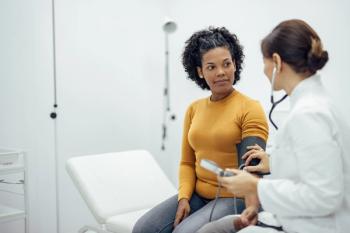
Oral contraceptives for the treatment of pain associated with endometriosis
This department will take a hard look at some of the common things done in OB/Gyn practice.
This department will take a hard look at some of the common things done in ob/gyn practice, such as supplementing iron during prenatal care, giving antibiotics before gynecologic surgery, and screening for asymptomatic bacteriuria, and will review the evidence supporting the approach. By examining the available evidence, using resources such as randomized clinical trials, meta-analyses, and the Cochrane Collaboration, we will make a blunt assessment of what we know and how effective our interventions really are. In many cases, the results may be surprising, and in some cases, this department will be less about "What We Know" and more about "What We Think We Know But Really Don't."
Case: A 26-year-old patient (nulligravida) with suspected endometriosis presented to your ob/gyn clinic 1 month ago with complaints of dysmenorrhea and dyspareunia. On physical exam, you noted a mobile uterus with tender nodules in the posterior cul-de-sac. Based on the patient's symptoms and pelvic examination, you suspected endometriosis and started her on a combined oral contraceptive. Today, she returns with complaints of minimal to no improvement in her symptoms in spite of the medical therapy prescribed. She asks, "Will these pills really help my pain?"
Endometriosis is a disorder characterized by ectopic endometrial tissues, most commonly found on the pelvic peritoneum or ovary.1 Endometriosis occurs in 7% to 10% of women in the general population and in 71% to 87% of women with chronic pelvic pain.1 Signs and symptoms include dysmenorrhea, dyspareunia, dyschezia, chronic pelvic pain, and infertility. There is significant debate about the effectiveness of therapy for the treatment of pain associated with endometriosis.
Progestogens, danazol, gonadotropin-releasing hormone (GnRH) analogues, and antiprogestogens have also been used for the treatment of endometriosis-related pain.5 However, clinical trials involving these treatments are difficult to perform, and few have been completed. In particular, studies involving oral contraceptives have had difficulties with patient compliance and sample size, and few studies have compared these agents with other treatments. In a Cochrane review, it was noted that limited data from randomized trials are available regarding treatment of endometriosis-associated pain with oral contraceptives.6
Although literature to support the use of oral contraceptives for pain associated with endometriosis is limited, several studies provide some support.4,7,8 One randomized, controlled study of oral contraceptives for the treatment of endometriosis-associated pain found no difference in outcomes between an oral contraceptive pill and a GnRH analogue in treating endometriosis-associated pain, with both agents significantly reducing painful symptoms.7 Women treated with the GnRH analogue were more likely to experience hot flushes, insomnia, and vaginal dryness, whereas women treated with the oral contraceptive pill were more likely to experience headaches and weight gain. Six months after treatment was discontinued, no significant differences were reported in symptom reoccurrence between the groups.7 A double-blind, randomized, placebo-controlled trial that evaluated the efficacy of a low-dose oral contraceptive pill for patients with dysmenorrhea associated with endometriosis found that patients taking the oral contraceptive pill had significantly less dysmenorrhea than did patients taking placebo.8 Another option for patients is continuous oral contraceptive therapy. Several studies have demonstrated that women who experience pain during menses may benefit from this continuous therapy,3 and a prospective trial found that continuous oral contraceptive therapy can be considered an effective treatment in women with symptomatic endometriosis.4
The limited available evidence suggests that oral contraceptives are an appropriate first-line therapy for pain associated with endometriosis. This regimen combines relief of pain, prevention of estrogen-deprivation effects, good tolerability, option for prompt cessation of use, contraception, low costs, and the possibility of indefinite therapy.4 Patients must be informed that medical therapy takes time and will require long-term treatment. Some clinicians would suggest switching the patient to a different therapy if the pain is unrelieved after 6 months; however, little persuasive evidence exists to support this recommendation. Treatment should be individualized to the provider and the patient.
REFERENCES
1. Ozawa Y, Murakami T, Terada Y, et al. Management of the pain associated with endometriosis: an update of the painful problems. Tohoku J Exp Med. 2006;210(3):175-188.
2. Sanfilippo JS, Hur HC. Oral contraceptives for endometriosis-associated pain. J Minim InvasiveGynecol. 2006;13(6):525-527.
3. Vercellini P, Somigliana E, Vigano P, Abbiati A, Barbara G, Crosignani PG. Endometriosis: current therapies and new pharmacological developments. Drugs. 2009;69(6):649-675.
4. Vercellini P, Frontino G, De Giorgi O, Pietropaolo G, Pasin R, Crosignani PG. Continuous use of an oral contraceptive for endometriosis-associated recurrent dysmenorrhea that does not respond to a cyclic pill regimen. Fertil Steril. 2003;80(3):560-563.
5. Practice Committee of the American Society for Reproductive Medicine. Treatment of pelvic pain associated with endometriosis. Fertil Steril. 2008;90(5 suppl):S260-269.
6. Davis L, Kennedy SS, Moore J, Prentice A. Modern combined oral contraceptives for pain associated with endometriosis. Cochrane Database Syst Rev. 2007;(3):CD001019.
7. Vercellini P, Trespidi L, Colombo A, Vendola N, Marchini M, Crosignani PG. A gonadotropin-releasing hormone agonist versus a low-dose oral contraceptive for pelvic pain associated with endometriosis. Fertil Steril. 1993;60(1):75-79.
8. Harada T, Momoeda M, Taketani Y, Hoshiai H, Terakawa N. Low-dose oral contraceptive pill for dysmenorrhea associated with endometriosis: a placebo-controlled, double-blind, randomized trial. Fertil Steril. 2008;90(5):1583-1588.
Disclaimer: Reference herein to any specific commercial products, process, or service by trade name, trademark manufacturer, or otherwise does not necessarily constitute or imply its endorsement, recommendation, or favoring by the United States Government. The opinions of the authors expressed herein do not necessarily state or reflect those of the United States Government and shall not be used for advertising or product endorsement purposes.
LT BRANKIN, MD, MC, USN is a resident in obstetrics and gynecology at Naval Medical Center San Diego, California. CDR CACKOVIC, MD, MC, USN is a maternal-fetal medicine physician at Naval Medical Center San Diego, California. Department Editor EDMUND F FUNAI, MD, is chief of obstetrics, Yale-New Haven Hospital, and associate chair for clinical affairs, Department of Obstetrics, Gynecology & Reproductive Sciences, Yale School of Medicine, New Haven, Connecticut. Neither the authors nor the section editor have financial or other relationships to disclose related to the products discussed in this article.
Newsletter
Get the latest clinical updates, case studies, and expert commentary in obstetric and gynecologic care. Sign up now to stay informed.











